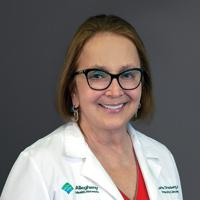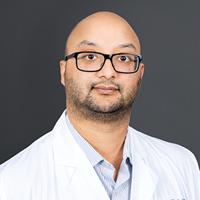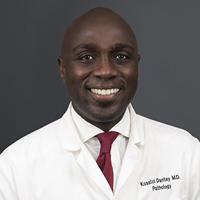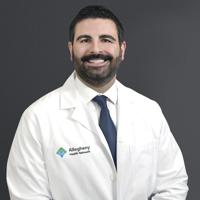Learn more about our appointment options, referrals, and what to bring to your first appointment.

Orthopaedic Oncology Division
About the AHN Orthopaedic Oncology Division
Our orthopaedic oncology specialty program plays a vital role in improving the quality of life for patients with bone and soft tissue tumors. We provide compassionate, comprehensive care while aiming for the best possible functional and oncological outcomes. By choosing AHN for your care, you receive multidisciplinary care as your specialists work together to treat your cancer. We treat all ages and collaborate with both the AHN Orthopaedic Institute and AHN Cancer Institute.
What is orthopaedic oncology?
Orthopaedic oncologists are specialized surgeons who focus on the diagnosis and treatment of cancers that affect the musculoskeletal system — that is, bones, joints, muscles, tendons, ligaments, and nerves. We specialize in benign and malignant neoplasms (cancers and tumors) of the musculoskeletal system, which includes the extremities, pelvis, spine, and all the tissue types that make that up, such as bone and soft tissue (broad types).
We treat patients with benign and malignant primary cancers of the musculoskeletal system as well as those dealing with metastatic disease to the skeleton. We are one of few places in the country with specific team care for these rare, orphaned diseases.
These diseases require expertise from diagnosis to treatment to surveillance. We employ all the available technologies for percutaneous biopsy and treatments including robot/custom/navigation guided surgeries, tumor profiling, and targeted systemic therapies.
You can expect coordinated care every step of the way, including:
- Prehab
- Nutrition
- Mental health
- Physical and occupational therapy
- Research and tumor profiling with genomics
- Radiology
- Pathology
- Lymphedema therapy for those diagnosed with lymphedema
The care providers involved meet weekly with the AHN tumor board and multi-institutional sarcoma tumor board to coordinate care. Other institutions involved include Marshall University, West Virgina University, and a private practice. There we discuss the toughest cases to multiple institutions with sarcoma expertise for built-in second, third, and fourth opinions. With your permission, we can present your case to see what the consensus is, as there is no single approach to care.
-
Appointments
Orthopaedic OncologyScheduler
Our programs
Sarcoma Center of Excellence
The AHN Sarcoma Center of Excellence is made up of a team of multiple health care experts walking you through every step of your cancer diagnosis and treatment. At AHN, we strive to make your treatment course as seamless and comfortable as possible. We will take care of appointment scheduling, imaging planning, and other aspects of care coordination for our patients so you have time to focus on healing and recovery.
Metastatic Disease to the Skeleton Program
Our Metastatic Disease to the Skeleton Program is devoted to taking care of patients with types of organ cancers — such as lung, prostate, breast, thyroid, and renal cancers — that most commonly metastasize to bones. We take care to prevent and treat fractures because of those metastatic lesions. Sometimes they can overlap with metabolic disorders of the skeleton. We also pay special attention to infections because they can be mistaken for tumors or vice versa.
Aggressive Benign Bone and Soft Tissue Tumor Program
Our Aggressive Benign Bone and Soft Tissue Tumor Program treats a group of growths that, while not cancerous, display aggressive growth patterns and can cause significant problems. Benign tumors are not malignant (cancerous) and don't spread to other body parts (metastasize). Despite being noncancerous, these tumors grow quickly and can invade surrounding tissues, potentially damaging nearby structures like nerves, blood vessels, and even bone. Bone tumors originate in bone tissue, while soft tissue tumors develop in the tissues connecting, supporting, or surrounding other structures, like muscles, tendons, ligaments, fat, or blood vessels.
Treating bone and soft tissue tumors
Our multidisciplinary approach means you have different specialists working together for your treatment plan.
Sarcoma care
If you have a sarcoma, it is cancer that arises from tissue in the musculoskeletal system. This includes bone or soft tissue, from the fat, muscles, nerve, blood vessels, connective tissue around the bone.
We work closely with medical oncology and radiation oncology throughout care to understand your overall health. Radiologists may help gather the biopsy to send for testing. A pathologist tests a sample to help us make an official diagnosis. An open biopsy for diagnosis allows us to make a multidisciplinary plan specific to your needs.
Many sarcomas require surgery by wide incision. This varies for each individual case based on the specifics of the tumor, such as the size, location, and what tissue it is located in and next to. Our first goal is to remove the cancer with negative margins. The close second goal is to optimize function after removing cancer or reconstruct areas to negate defects after surgery.
Surgical approaches include:
- Intraoperative navigation
- Custom cutting guides
- Custom reconstructions
- Multidisciplinary surgical coordination with vascular surgery
- Plastic surgery or thoracic surgery to take out these cancers and reconstruct the area
For benign tumors, we often employ standard of care resections (marginal resections) that do not have to take out extra tissue. We may use other treatment options to minimize surgical impacts such as cryoablation and radio frequency ablation.
Learn more about our Sarcoma Center of Excellence.
Soft tissue and bone sarcomas
Soft tissue sarcomas originate in muscles, tendons, fat, nerves, blood vessels, and deep skin tissues. They can develop anywhere in the body, but are most common in the arms, legs, chest, and abdomen. Bone sarcomas develop in the bones. They are most often found in the long bones of the arms and legs, but they can occur in any bone.
Treatment may include:
- Radiation (multiple types, MR Linac)
- Chemotherapy/systemic/immunotherapies/targeted therapies
- Surgery and interventional abilities
- Bone resections reconstruct areas with mega prosthetics like joint replacements, but with replacement of much more of the skeleton (complex arthroplasty).
- For big soft tissue resections, we count on plastic surgeons to perform all types of soft tissue reconstruction, including skin grafts, rotational flaps, free flaps, and more.
Benign bone and soft tissue tumors may not be cancer, but can be life-changing and disruptive to function. We have broad abilities to monitor and treat these in ways that are best for each individual patient.
Learn more about soft tissue sarcomas.
Metastatic disease
Metastatic diseases of the soft tissues and bone occur when cancer cells from a primary tumor in another part of the body spread to these areas.
Our goals are to prevent impending fracture and to treat pain. We fix completed fractures with a focus on quality of life in function, pain control, and, if needed, your ability to undergo cancer treatments.
Metabolic disorders of the skeleton
Metabolic bone diseases are a group of conditions that affect bone strength or integrity due to problems with the body's processes of bone building and breakdown. These processes are ongoing and vital for maintaining healthy bones.
We treat metabolic disorders of the skeleton including:
- Osteoporosis: The most common metabolic bone disorder, characterized by low bone mass and deterioration of bone tissue, leading to increased fracture risk.
- Osteomalacia/rickets: Inadequate bone mineralization usually due to vitamin D deficiency. In children, it's called rickets and leads to soft, weak bones. In adults, it's called osteomalacia and causes bone pain and weakness.
- Hypophosphatasia: A rare genetic disorder affecting bone mineralization due to low levels of an enzyme called alkaline phosphatase.
- Paget's disease of bone: Disruption in the normal bone remodeling cycle, leading to enlarged and misshapen bones that are weaker than normal.
- Hyperparathyroidism: Overactive parathyroid glands produce too much parathyroid hormone, which pulls calcium from the bones, weakening them.
- Osteogenesis imperfecta: A group of genetic disorders causing fragile bones that break easily.
- Bone cancer: Cancerous cells in the bone can weaken bone structure.
- Drug-induced bone loss: Certain medications, like corticosteroids, can lead to bone loss as a side effect.
- Musculoskeletal infections: This can often look like or have symptoms similar to tumors. We are one of two facilities in the area that treat these issues.
Metastatic care
Orthopaedic oncology metastatic care focuses on managing cancer that has spread to the bones from a primary tumor elsewhere in the body (bone metastases). It requires a multidisciplinary approach to alleviate symptoms, improve quality of life, and potentially extend survival.
At AHN, we take into account the type of cancer, where it is, and how active you are to determine the best metastatic care plan for you. We coordinate your surgical care with other treatments to optimize care and minimize complications to help treat your quality of life, not just the cancer.
Learn more about our Metastatic Disease to the Skeleton Program.
Specialists working with orthopaedic oncology
AHN orthopaedic oncologists are focused on providing individualized, comprehensive care to their patients. We offer multidisciplinary care in a variety of locations so you can see the specialist you need closer to home.
Surgery

Orthopaedic Oncology Surgeon

Orthopaedic Surgeon

Physician Assistant
Medical Oncology

Medical Oncologist

Physician Assistant
Radiation Oncology Leads

Radiation Oncologist

Radiation Oncologist

Radiation Oncologist

Radiation Oncologist
Pathology

Pathologist

Pathologist
Radiology

Radiologist
How to get care
To make an appointment you can:
- Call our scheduler: (412) 359-8614
- Schedule online
- Use MyChart and schedule with Dr. Lisa Ercolano to make an appointment
Please bring all relevant imaging on a CD or through PowerShare with correlating reports for review by our team to your initial appointment.
You can expect to meet the orthopaedic oncology team and get a brief overview of the treatment timeline. Your appointments may feel overwhelming at times, so write down your questions and bring them with you to the office. It can be helpful to bring someone who can act as your support. These people can help you remember details discussed in the office and be there or you, if needed, throughout the appointment.
Clinical trials and research
AHN participates in clinical trials of new therapies that are open for patients who qualify and wish to participate. Patients are screened for consideration with ongoing clinical trials at every stage of their treatment.
What is a clinical trial
Clinical trials are studies that try to answer questions about new ways to treat cancer with medications, radiation, or surgical techniques. Previous trials have shown how new methods of treatment improve survival and quality of life and reduce the risk of cancer returning.
You participate in a clinical trial only if you volunteer to do so and meet criteria for inclusion in the study, and you can stop participating in a trial at any time.
Who can join a clinical trial?
The plan for the trial, called a protocol, explains what the trial will do and how the study will be done. Based on the questions the research is trying to answer, each clinical trial protocol outlines specific criteria necessary to be eligible to join the trial.
Common criteria for entering a trial are:
- Having a certain type or stage of cancer.
- Having received a certain kind of therapy in the past.
- Being in a certain age group.
- Federal rules help ensure that clinical trials are run in an ethical manner, with your rights and safety protected. It’s to ensure that you’re not put at increased risk by participating in the trial, and that the results of the study are accurate and meaningful.
Conducting clinical trials helps us contribute to Cancer Moonshot — an initiative created by former President Joe Biden and the White House. The goal is to prevent more than 4 million cancer deaths by 2047 and improve the experience for people affected by cancer. We’re doing our part to join this fight by collaborating with more than 60 private companies, patient groups, academic institutions, and nonprofits.
Currently active cancer clinical trials
If you would like to participate in a clinical trial and help our innovative team discover groundbreaking cancer solutions, ask your doctor if you’re eligible to participate in one. Find currently active clinical trials that are open for participation.
Refer your patient to an AHN specialist
Referrals are sent to Allegheny Orthopaedic Associates (AOA) - Lisa Ercolano
- All outside referrals can be faxed to (412) 359-4988. Referrals should include relevant office notes and imaging of concern.
- When the referral is received, we will call the patient directly to schedule an appointment.
- Providers can call our office to discuss a particular case or patient with a provider directly.
- We are able to fax or share information via EPIC EMR to share any information necessary to the patient's primary doctor or an outside facility.
For more information about referring your patient to an AHN specialist, read the Independent Physician Referral FAQs.
Follow your patient's health care at AHN with EpicCare® Link™
After referring your patient to an AHN specialist, use the EpicCare Link platform to collaborate with their AHN specialist, and view your patient's test results, treatment plan, and progress.
If you are new to EpicCare Link, or need to request your own EpicCare Link account, read: EpicCare Link for Patient Follow-up, for user instructions and new account request forms.
When EpicCare Link is not an option for a patient's AHN medical records
If you can’t access your patient's AHN test results through the EpicCare Link platform, your patient will need to complete and submit the correct AHN Medical Records Release form, based on their state of residency. Support your patient’s request by downloading the correct medical records release form for them:
EpicCare® is a registered trademark of Epic Systems Corporation and used with permission.
EpicCare® Link™ is a trademark of Epic Systems Corporation and used with permission.

